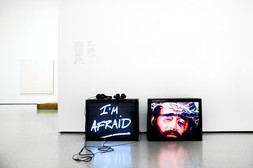In case you missed it, I want to point out an article in Monday’s Wall Street Journal by Pia Catton, which attempts to set the record straight on some misunderstandings about David Wojnarowicz’s “A Fire in My Belly,” the work yanked from the National Portrait Gallery’s “Hide/Seek” exhibition.
 For a start, she says, quoting the artist’s executor, the work had nothing to do with his case of AIDS or the AIDS epidemic, as so many people have written. Including the wall label at MoMA, according to the article.
For a start, she says, quoting the artist’s executor, the work had nothing to do with his case of AIDS or the AIDS epidemic, as so many people have written. Including the wall label at MoMA, according to the article.
Even today’s Washington Post, which reports on the outcome of yesterday’s meeting of Smithsonian regents on the affair — no surprise, they supported Secretary Wayne Clough though, according to various reports, they did not vote on whether or not the film should have been removed from the exhibit — contains these passages:
The mistake was not having enough time to explain the iconography of the art itself and its meaning at the onset of the AIDS crisis.
And:
The video by the late Wojnarowicz was created in 1987 to show the pain and sorrow that the AIDS epidemic was creating, especially in the gay community.
The whole episode is, imho, a manifestion of everyone losing his or her head, too quickly, without knowing all the facts. Instead of creating a teachable moment, everyone stoked the controversy. Thus no one has done himself, or herself, proud.
While I encourage you to read the whole WSJ article, here are a few critical passages:
…the people closest to the artist’s estate say the film and its creator have been too narrowly interpreted….
…”A Fire in My Belly”–which was made on Super8 mm film and is not, contrary to media reports, a “video”–predates Mr. Wojnarowicz’s discovery that he was HIV positive, which Mr. [Tom] Rauffenbart said occurred in March 1988. “The film was shot before David was diagnosed and before he got involved with the AIDS movement,” said Mr. Rauffenbart, who was the artist’s partner for seven years. Considered in a broader context, the film’s footage of street scenes in Mexico and of various forms of fighting reflects the artist addressing themes of violence, individuality and the effect of culture on a child.
…Regarding the crucifix scenes, Mr. Rauffenbart said they should be viewed in terms of Mr. Wojnarowicz’s extensive use of Catholic imagery: “He had a positive image of Christ and had his own version of what Christ represents. He was tied to saints, too, that suffered and were martyred.”
Rauffenbart, along with NYU, which holds Wojnarowicz’s papers, have compiled a fact sheet, which demands bigger circulation.
Photo Credit: Courtesy of the Wall Street Journal
